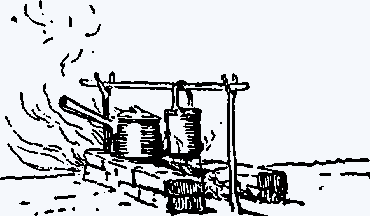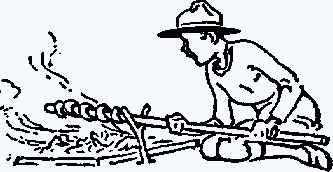Camp Fire Yarn No. 10
CAMP COOKING
Cooking • Hay-Box Cooking Bread Making • Cleanliness
Every scour must, of course, know how to cook his own meat and vegetables, and to make
bread for himself, without regular cooking utensils.
COOKING MEAT
Meat may be cooked by sticking it on sharp sticks and hanging it close to the fire, so
that it gets broiled. Or use the lid of an old cake tin as a kind of frying-pan. Put grease in it to prevent the meat from
sticking.
Or make "Kabobs:" cut your meat up into a slice about half or three-quarters of an inch
thick. Cut this up into small pieces about one to one and a half inches across. String a lot of these chunks on to a stick
or iron rod, and plant it in front of the fire, or suspend it over the hot embers for a few minutes till the meat is roasted.
Meat can also be wrapped in a few sheets of wet paper, or in a coating of clay, and put
in the red-hot embers of the fire, where it will cook by itself.
Hunter's Stew-Cut lean meat or game into small chunks about an inch or one and a half
inches square. Mix some flour, salt, and pepper together, and rub your meat well in it. Brown it in a little fat in the pot,
shuffling the pot so as to sear, but not burn the surfaces of the meat. Add clean water, and hang pot high over the fire.
It is important that the water should not boil hard, but merely simmer. Later add cut-up vegetables, such as potatoes, carrots
and onions. The water should just cover the food-no more. Cook until tender.
Cooking Birds and Fish
Birds and fish can be cooked in the same manner. A bird is most easily plucked immediately
after being killed. But there is no need to pluck it before cooking it in clay, as the feathers will stick to the clay when
it hardens in the heat, and when you break it open the bird will come out cooked, without its feathers, like the kernel out
of a nutshell.
Another way is to clean out the inside of a bird, get a stone about the size of its inside,
and heat it till nearly red hot. Place it inside the bird, and put the bird on a gridiron, or on a wooden spit over the fire.

FIRE PLACES
Usually a Scout has his own pot of "billy" or camp kettle. In that you can boil water
or cook your vegetables or stew your meat.
To cook in your pot, you can either stand it on the ends of the logs of a star fire (where
it may fall over unless care is taken), or, better, stand it on the ground among the hot embers of the fire. Or rig up a tripod
of three green poles over the fire, tying them together at the top, and hanging the pot by a wire or chain from the poles.
Even better, make a fire of two lines of sods, bricks, thick logs, or stones. The lines
should be flat at the top and about six feet long, four inches apart at one end and eight inches at the other-the big end
toward the wind.
Then you should make your own pot hooks and hangers for holding your cooking pots over
the fire.
COOKING HINTS
When boiling a pot of water on the fire, do not jamb the lid on too firmly. When the steam
forms inside the pot, it must have some means of escape. To find out when the water is beginning to boil, you need not take
off the lid and look, but just hold the end of a stick or knife to the pot, and if the water is boiling you will feel the
pot trembling.
Oatmeal Porridge-Pour into a pot one cup of water for each person. Add a pinch of salt
for each cup. When the water boils, sprinkle oatmeal in it while stirring with a stick or large spoon. The amount of oatmeal
depends upon whether you want the porridge thick or thin. Simmer the porridge until it is done, stirring all the time.
Don't do as I did once when I was a "tenderfoot". Tt was my turn to cook, so I thought
I would vary the dinner by giving them soup, I had some pea-flour, and I mixed it with water and boiled it up, and served
it as pea-soup. But I did not put in any stock or meat juice of any kind, I didn't know that it was necessary or would be
noticeable. But they noticed it directly, called my beautiful soup a "wet pea-pudding", and told me I might eat it myself-not
only told me T might, but they jolly well made me eat it. 1 never made the mistake again.
Hay-Box Cooking
Hay-box cooking is the best way of getting your cooking done in camp, as you only have
to start it and the hay-box does the rest. You can then go out and play your camp games with the other fellows, and come back
to find that your dinner has cooked itself- that is, if you started it right. If you didn't-well, you won't find yourself
very popular with the Patrol!
This is how you start it: get a box. Line it with several thicknesses of newspaper at
sides and bottom, then fill it with hay or more newspapers ; pack this all tight with a space in the middle for your cooking
pot. Plenty of hay below as well as round the pot. Make a cushion packed with hay for the top, or a thick pad of folded newspapers.
Get your stewpot full of food, and as soon as it is well on the boil, pop it into the
hay-box. Pack the hay or paper tight round it and over it, put on the covering pad, and jam down the lid with a weight on
it.
Meat will take four or five hours to cook in this way. Oatmeal you should boil for five
minutes, and leave in hay-box all night. It will be ready for your early breakfast.
Bread Making
"The three Bs of life in camp are the ability to cook bannocks, beans, and bacon."
To make bread, or bannocks, or "dampers", the usual way is to mix flour with a pinch or
two of salt and of baking powder, then make a pile of it and scoop out the centre until it forms a cup for the water, which
is then poured in. Mix everything well together until it forms a lump of dough. With a little fresh flour sprinkled over the
hands to prevent the dough sticking to them, pat it and make it into the shape of a large bun or several smaller buns.
Then put it on a gridiron over hot embers. Or sweep part of the fire to one side, and
put the dough on the hot ground left there and pile hot ashes round it and let it bake.
Only small loaves can be made in this way.

Twist
Still another way is to cut a stout stick, sharpen its thin end, peel it, and heat it
in the fire. Make a long strip of dough, about two inches wide and half an inch thick and wind it spirally down the stick.
Plant the stick close to the fire and let the dough toast, just giving the stick a turn now and then.
Baking Oven
If real bread is required, a kind of oven should be made, either by using an old earthenware
pot or a tin box, and putting it into the fire and piling embers all over it. Or make a clay oven, light a fire inside it,
and then, when it is well heated, rake out the fire, and put the dough inside, and shut up the entrance tightly till the bread
is baked.
CLEANLINESS
Scouts take special care to keep the kitchen particularly clean. They are careful to clean
their cooking pots, plates, forks, knives, very thoroughly. They know that if dirt and scraps of food are left about, flies
will collect.
Flies are dangerous, because they carry disease germs on their feet, and if they settle
on your food they often leave the poison there for you to eat-and then you wonder why you get ill.
For this reason you should be careful to keep your camp kitchen very clean, so that flies
won't come there. All slops and scraps should be burned or thrown into a properly dug hole, where they can be buried, and
not scattered all over the place.
Patrol Leaders are responsible for seeing that this is always done.
Remember, "A Scout is clean".
PATROL PRACTICES IN COOKING
Scouts should be able to cook before they go to camp. Teach them the most important things,
such as cooking potatoes and porridge, meat and vegetables. These can be practised during the winter.
Practise mixing dough and baking twists and dampers.
Make a hay-box and use it.
Make your own linen ration bags.
Patrols should compete in preparing menus, working out quantities, etc.
Bring raw rations on a bike, make a fire and cook your own meal.
Experiment with different types of fire places until you arrive at the one you think most
suitable for your Patrol Cooking. Then try making a number of kitchen gadgets.

